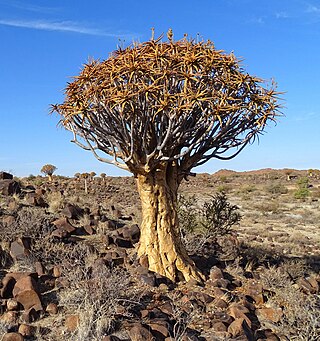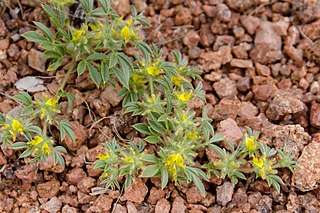
Freesia is a genus of herbaceous perennial flowering plants in the family Iridaceae, first described as a genus in 1866 by Christian Friedrich Ecklon (1886) and named after the German botanist and medical practitioner, Friedrich Freese (1795-1876). It is native to the eastern side of southern Africa, from Kenya south to South Africa, most species being found in Cape Provinces. Species of the former genus Anomatheca are now included in Freesia. The plants commonly known as "freesias", with fragrant funnel-shaped flowers, are cultivated hybrids of a number of Freesia species. Some other species are also grown as ornamental plants.

Tulbaghia is a genus of monocotyledonous herbaceous perennial bulbs native to Africa, belonging to the amaryllis family. It is one of only two known genera in the society garlic tribe within the onion subfamily. The genus was named for Ryk Tulbagh (1699–1771), one time governor of The Cape of Good Hope.

Stapelia is a genus of low-growing, spineless, stem succulent plants, predominantly from South Africa with a few from other parts of Africa. Several Asian and Latin American species were formerly included but they have all now been transferred to other genera. The flowers of certain species, most notably Stapelia gigantea, can reach 41 cm (16 inches) in diameter when fully open. Most Stapelia flowers are visibly hairy and generate the odor of rotten flesh when they bloom.

Aloidendron dichotomum, formerly Aloe dichotoma, the quiver tree or kokerboom, is a tall, branching species of succulent plant, indigenous to Southern Africa, specifically in the Northern Cape province of South Africa, and parts of Southern Namibia.

Gasteria is a genus of succulent plants, native to South Africa and the far south-west corner of Namibia.

Dimorphotheca sinuata, the glandular Cape marigold, Namaqualand daisy, or orange Namaqualand daisy; syn. Dimorphotheca aurantiaca hort.) is a species of plants native to southern Africa. It is also widely cultivated as an ornamental and naturalized in parts of the United States, primarily California and Arizona.

Melhania is a genus of small shrubs or herbaceous plants. Traditionally included in the family Sterculiaceae, it is included in the expanded Malvaceae in the APG and most subsequent systematics. The genus is named for Mount Melhan in Yemen.

Strumaria is a genus of African plants in Amaryllis family, subfamily Amaryllidoideae. The genus is known in nature only from South Africa, Lesotho and Namibia. Almost all species flower in the autumn and are cultivated as ornamental bulbous plants.

Leobordea platycarpa is a common annual plant in the drier parts of the African continent found in open ground, roadsides, cultivated ground and other disturbed places or in short grassland on sand.

Wurmbea is a genus of perennial herbs in the family Colchicaceae, native to Africa and Australia. There are about 50 species, with about half endemic to each continent.

Cyanella is a genus of cormous perennial herbs native to South Africa and Namibia, first described for modern science in 1754.
Hilliardia is a monotypic genus of South African flowering plants in the daisy family. It only contains one known species, Hilliardia zuurbergensis(Oliv.) B.Nord.

Albuca is a genus of flowering plants in the family Asparagaceae, subfamily Scilloideae. The genus is distributed mainly in southern and eastern Africa, with some species occurring in northern Africa and the Arabian Peninsula. Plants of the genus are known commonly as slime lilies.

Englerophytum is a group of trees in the family Sapotaceae described as a genus in 1914.

Fockea is a genus of succulent scrubs native to Africa south of the equator. They are members of the Asclepiadoideae (milkweeds), a subfamily of the dogbane family Apocynaceae. Of the six recognized species, only the two most widely distributed extend north of southern Africa, with F. multiflora reaching as far north as Tanzania and F. angustifolia reaching to southern Kenya. Fockea are known as water roots, a reference to the bulbous caudex characteristic of most species, which is also edible in at least some species.

Stapeliopsis is a genus of succulent plants in the family Apocynaceae, native to southern Africa.
Capelio is a genus of flowering plant in the Asteraceae first described as a genus in 1836 with the name Alciope. It was renamed Capelio in 2002 after it was determined that the name Alciope was not legitimately published according to international nomenclatural rules. Capelio is a taxonomic anagram derived from the former name Alciope.

Ornithoglossum undulatum, also known as the Karoo Slangkop, is a species of flowering plant in the family Colchicaceae. It is found in Southern Namibia and South Africa. In South Africa its range extends as far east as Somerset East in Eastern Cape Province. O. undulatum is a poisonous plant, and consumption of the leaves can kill livestock.
















